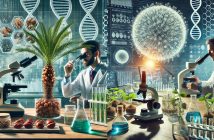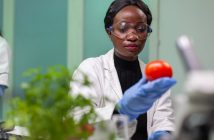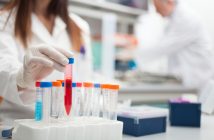In recent years, the clean label movement has been making headway in the food industry. Traditional methods of food production that relied on heavy processing and artificial ingredients are losing traction with current consumers, while fast-growing food startups boasting products in the good-for-you category are continuing to gain market share. While many of flavors used in the food industry are still produced using synthetic chemistry and petrochemical feedstocks, consumer desire for natural flavors is also on the rise. At the same time, most food products are not fully ‘synthetic’; the main source of all foods we eat today is still from plants and animals, even if there is some chemical and biological modification along the way. Here we outline some brilliant innovations in synthetic foods:
NASA and the Food Synthesis Project
Between the 1960s and 1970s, the NASA Ames Research Center embarked on a project to produce food without using traditionally eaten living organisms, such as crops or livestock. The basic premise of the project was that astronauts would continue to explore space on longer and longer missions. The space and weight available for stored foods aboard spacecraft would be limited, and other processes would be needed to feed the human crew. While growing food was considered a viable option, the speed and area in which food could be grown would limit the amount of food available at any point in time. Instead, the program investigated simple chemical methods that could regenerate food using waste products and rocket fuel.
Several publications were published on processes developed to generate edible carbohydrates from water, carbon dioxide, and electricity. These processes relied on the electrochemical splitting of water into hydrogen and oxygen gas. The hydrogen gas would be reacted with carbon dioxide, captured from the exhalation of aerospace crew, to form methane. Methane would then be converted into formaldehyde by a careful partial oxidation with oxygen and led into a series of catalyzed reactions that formed formose sugars or glycerol from the formaldehyde. Formose sugars are similar to the typical sugars we eat, such as glucose, sucrose, or fructose, and so can be readily digested by humans for energy. Glycerol is a common intermediate formed in the human body on the way to metabolizing sugars, and so is also an edible product. These pure carbohydrate products can be further reacted together to form long polymers similar to starch or used directly as sweeteners.
The mechanisms and transformations in the #formose reaction are reviewed. http://t.co/O89Tw7iS9W pic.twitter.com/gAGdcjskgJ
— ChemSusChem (@ChemSusChem) June 17, 2014
The overall food-generating system would only be limited by the amount of electricity available to run the electrolysis reaction to form hydrogen and could provide the bulk of carbohydrate calories needed by humans. Lipids and proteins are also required for a balanced diet, but the chemical processes needed to produce these food compounds are complicated and laborious. To bypass these challenges, the investigators suggested using a bacterium, Hydrogenomonas eutropha, which feeds on hydrogen gas, carbon dioxide, and minerals, and converts these into a protein-rich supplement that also contains lipids, vitamins, and other essential nutrients needed by the human body. Although a living organism would be used in this process here, the bacteria could produce biomass quickly and without extensive maintenance. That way, an entire diet could be produced using only simple chemical and biological technologies that could be placed in a space craft. However, the technology was never implemented in any practical form for space missions.
Synthesis of Food Using Electricity
Recently, in a joint project between the VTT Technical Research Centre of Finland and Lappeenranta University of Technology, researchers developed a method to produce a high-protein food product from water, carbon dioxide, bacteria, and electricity. Like the bacterial process mentioned before, the bacteria used here is a special type that can digest the hydrogen gas produced from the electrolysis of water and carbon dioxide captured from the burning of fossil fuels, and convert those into edible biomass.
A Team of Scientists Just Made Food From Electricity — and it Could be the Solution to World Hunger https://t.co/RhowrhVLuv #Finland
— Earth Accounting (@EarthAccounting) August 5, 2017
The Food From Electricity project has the potential to reduce greenhouse emissions as an energy-efficient alternative way to create food. Unlike traditional agriculture, which relies on the energy conversion of sunlight to sugar through photosynthesis, electricity captured directly from solar panels could be used to power the process. The method is calculated to be ten times more efficient than producing crop-based agriculture. The other advantage is that the process can easily scaled and doesn’t require large tracts of land; a multistory warehouse would be able to produce the same output as a field of crops. Additionally, chemical pesticides and fertilizers that would normally run off and cause damage to the local environment would not be needed for this bacteria-based food production. Other ways to apply the technology include at-home devices that would generate food on demand for regions that struggle with adequate food supplies and could reduce the impact of global malnourishment.
Synthetic Meats
Other work spearheaded by NASA include research on synthetic meat technology. That work has since been spun out into various academic research projects and startup technologies. Synthetic, or cultured, meat relies on the same biotechnology developed to create replacement tissue and organs used in the medical field. Stem cells from the desired animal (cow, pig, fish, etc.) are grown in a nutrient-rich broth under sterile conditions. The stem cells are encouraged to differentiate into muscle tissue using a specialized medium containing factors that signal the cells to change. The matured muscle tissues are ‘exercised’ by stretching to promote muscle growth and harvested after the desired size is reached. The meat-like material is then shaped and flavored to give a meat product similar to the meat from an animal
Large-scale meat farming is largely unsustainable. Do you think synthetic meat is the answer? http://t.co/xxRLAxC9qE pic.twitter.com/yIYy9xzHyH
— Modern Farmer (@ModFarm) September 30, 2014
While still under development, cultured meat products have many advantages that make it an attractive alternative to the current ways in which we raise livestock and harvest their meat. Since the meat is grown in a closed, sterile environment, fewer antibiotics are needed to keep the product free of pathogens. The meat product itself would not harbor food-borne parasites or pathogens that could pose a health risk, unlike natural livestock. On top of that, waste produced from the process can be better managed, and even recycled. Currently, the nutrient media used to grow the meat tissues come from the wombs of birthing cows, but the eventual aim is to feed the cell cultures a media derived from plant sources, which could potentially reduce the environmental impact of meat production. Other advantages include the reduced amount of space needed to grow the meat, freeing up ranch and farm land for other uses, and the ability to manipulate the growing process to create tailored and hybrid meat materials. For example, the cells could be grown to include both fish and bovine tissue in its matrix, giving a unique product impossible to create otherwise. Or the tissues could be programmed to produce precise ratios of fat-to-protein, or higher concentrations of desired flavor compounds. Ultimately, synthetic meat technology can open doors to new opportunities, innovations, and culinary experiences yet to be seen.
Synthetics and Beyond
The term ‘synthetic’ tends to hold a negative connotation in our modern world. While the market is steadily shifting towards naturally-sourced products, growing environmental concerns and global socioeconomic challenges may require the food industry to rely on synthetically-derived food products. As we move into the future, a combination of both synthetic and natural foods will continue to be mainstays in our diets.
________________________________
Need to consult a food scientist or flavor chemist? Get in touch with a freelance food scientist.







